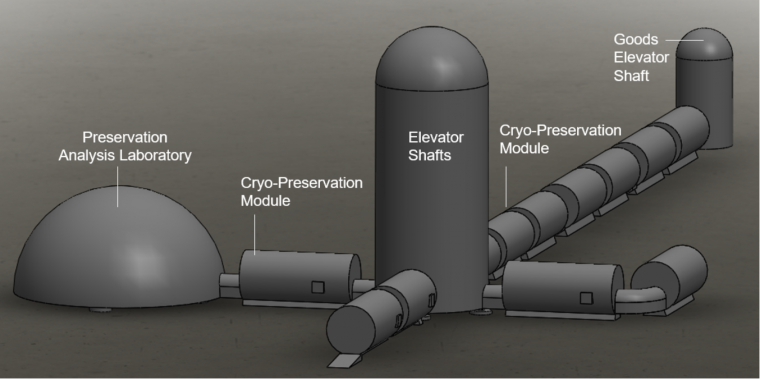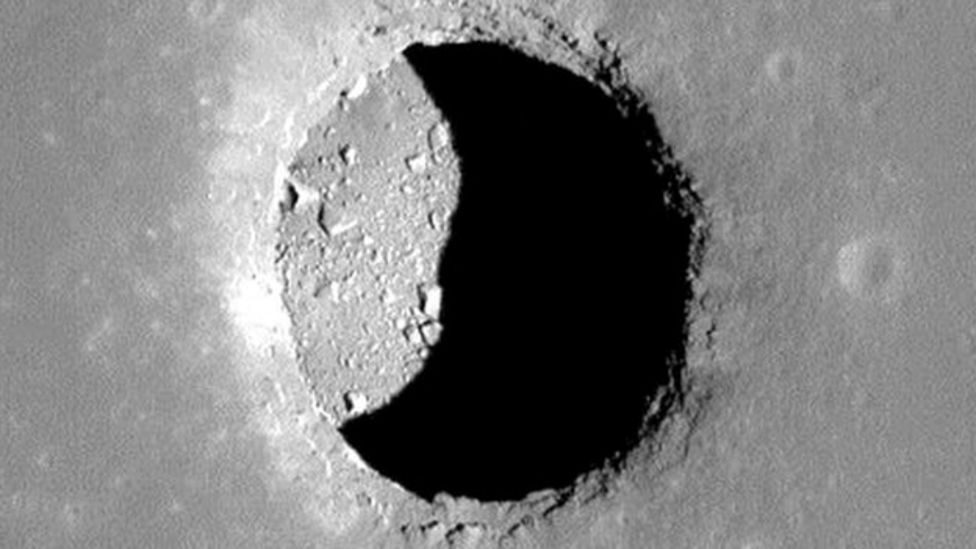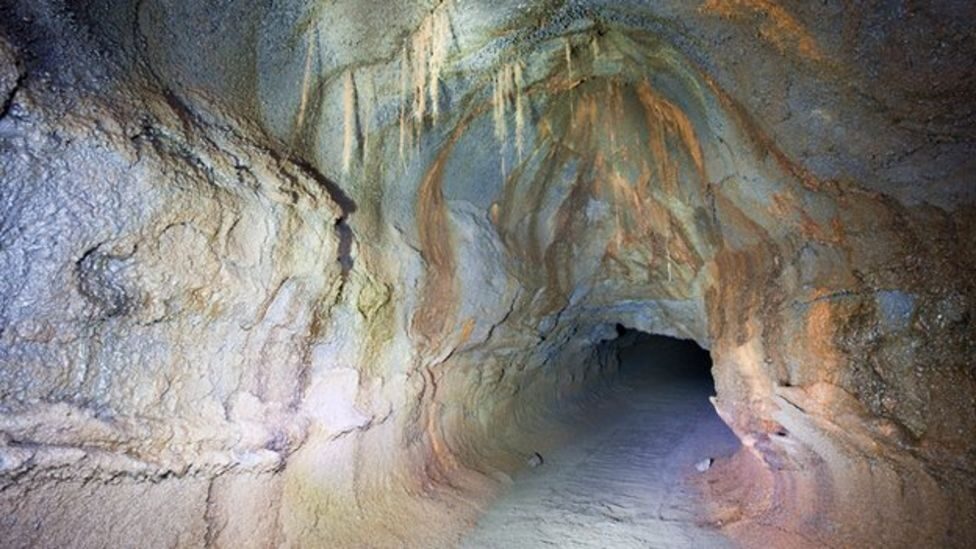This project is similar to Norway's "Doomsday" Seed Vault, which hosts more than 850,000 different seed samples in the frigid Arctic. Seeds are kept at -18 °C (-3 °F) and should be protected against a number of potential disasters, ranging from global warming to nuclear war.
Likewise, the lunar ark would deposit cryogenically frozen seeds, spores, sperm, and egg samples from millions of species of animals. In order to protect these precious samples, the ark would be stored inside one of the more than 200 lava tubes identified so far beneath the moon's surface.
A lava tube, or pyroduct, is a natural conduit formed by flowing lava from a volcanic vent that moves beneath the hardened surface of a lava flow.
These yawning, subterranean caverns can have heights that dwarf Dubai's Burj Khalifa. Untouched for the last billions of years, these lava tubes provide the perfect shelter from punishing solar radiation, which is why they've been identified as sites for future human bases.
But if we ever colonize the moon in a lava tube, why not take the extra step and build a genetic ark. Besides the ample space and radiation shielding, the temperature inside the lava tubes hovers around a constant -25° Celsius (-15° F), which is ideal for storing sensitive biological samples.
Earth also has lava tubes formed during its early years, but these are much smaller, about the size of subway tunnels, and have been eroded over time by earthquakes, plate tectonics, and other natural processes. The lunar caverns are much better suited to acting as a genetic vault.
"Earth is naturally a volatile environment," said Jekan Thanga, a professor of aerospace and mechanical engineering at the University of Arizona College of Engineering. "As humans, we had a close call about 75,000 years ago with the Toba supervolcanic eruption, which caused a 1,000-year cooling period and, according to some, aligns with an estimated drop in human diversity. Because human civilization has such a large footprint, if it were to collapse, that could have a negative cascading effect on the rest of the planet."Of course, building an ark on the moon is a huge undertaking. By Thanga's calculations, it would take at least 250 rocket launches to carry about 50 samples from each of the 6.7 million species on Earth. For comparison, it took about 40 rocket launches to build the International Space Station.
These samples would be housed in an underground facility powered by solar panels positioned on the moon's surface. Two or more elevator shafts would lead down to the facility where biological samples would be housed in various cryogenic preservation modules.
Inside the modules, the samples would float above metal surfaces thanks to a phenomenon known as quantum levitation. Maintenance would be ensured by robots navigating above magnetic tracks.
All of this may sound wack, but it definitely is in the realm of possibility — we already have the technology at our disposal after all. It's just a matter of directing resources and gaining public support.
Just the other day, China and Russia announced that they have plans to build a lunar outpost together. Elsewhere, the US has plans for its own lunar base called Artemis after it lands astronauts back on the moon in 2024.
"What amazes me about projects like this is that they make me feel like we are getting closer to becoming a space civilization, and to a not-very-distant future where humankind will have bases on the moon and Mars," said Álvaro Díaz-Flores Caminero, a University of Arizona doctoral student leading the thermal analysis for the project. "Multidisciplinary projects are hard due to their complexity, but I think the same complexity is what makes them beautiful."The project was described in a paper presented over the weekend during the IEEE Aerospace Conference.






Reader Comments
THE MOON IS SWELL...MAYBE WE'LL SEND A PERSON THERE SOME DAY.
Soon as we figure how to survive a ground zero radiation event.
RC
In 2015, Pari Spolter published a book entitled The Dance of the Moon . Out of 187 pages, 12 of it are commentary, and the rest are data tables on the moon's movements. That data was acquired through the aid of laser ranging, carried out in stages by Apollo missions 11, 14, & 15. Each of these placed hundreds of mirrors on the moon's surface to reflect laser light originating on earth. Each mission placed newer mirrors that facilitated the upgrade in laser technology. Before those missions, resolution was at 15cm. By the third mission it had been reduced to 1.1mm. !!
This kind of data is very hard to fake. There are oscillations in the Moon's orbit astronomers were not aware of before, and it has led to improvement in eclipse prediction, refined influence of the sun, gravitational constant, and a number of other related characteristics.
Its very hard for me to conceive as an engineer how those three missions could have been pulled off without the advantage of a learning curve in traveling to the moon. That there are things about them that don't add up, I have no doubt. BG Wallace strove for years to pry the data out of NASA from the interplanetary radar contact with Venus. Indications were that NASA knew then (1961) the speed of light was not constant. No matter what he tried, they would not release the original raw data, and he was forced to conclude they would not part with it (his Russian physicist associates alluded to the same) that the government did not want that information released to the world, so that the US could maintain a lead in the "space race."
Please understand what makes Joe Rogan's interviews informative is not just Joe Rogan, but the subjects he interviews. He conducts a darn good interview, but obviously the point of an interview is to extract information from the guest's expertise...right?
Here's a fun fact: Current technology does not provide for the ability to land people on the moon. That's odd. You can go ask them over at NASA about that.They're pretty open about the difficulties they now face replicating any adventure anywhere near the spectacular nature of what they did back when they invented the Ziploc bag. Currently they seem to be struggling to match wits with experts that amazingly landed 6 crews on the moon, drove around in space buggies, played golf etc. and delivered them all back safely 50 years ago...seems a bit odd myself.
If you've got a hankering for exploring official plot holes and BS, go check out that link RC put up there.
I don't see "moonwalkers" as a legend when there's the obvious fact those mirrors ARE on the moon, and astronomers have been using that data for decades now. Having worked with robotics over the years, I know that putting the kind of robots we're doing on Mars was not in their technical ability then. Robots in those days were not capable of placing >400 mirrors. Only very basic 4 bit microprocessors in the late 60s and nobody had high efficiency brushless motors. Mirrors on the moon are not the only evidence man was there.
“Progress, far from consisting in change, depends on retentiveness. When change is absolute there remains no being to improve and no direction is set for possible improvement: and when experience is not retained, as among savages, infancy is perpetual. Those who cannot remember the past are condemned to repeat it. In the first stage of life the mind is frivolous and easily distracted, it misses progress by failing in consecutiveness and persistence. This is the condition of children and barbarians, in which instinct has learned nothing from experience. ”
R.C.
They lost all the blue prints and design data? You don't say. That's a bummer. Oh well, Platex is still around. Go ask those kids to whip you up some more space tech. I bet they've learned a lot since 1969.